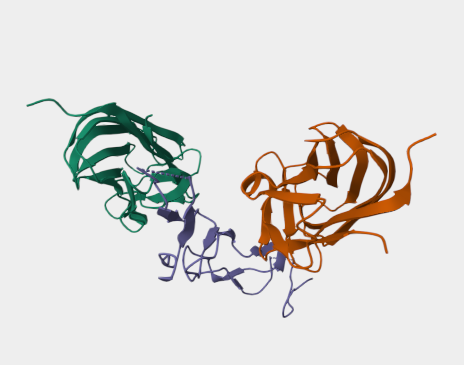Key features and details | |
Cat. No. | MABL-1465 |
Name | Anti-EDAR mAbs |
Clone No. | AFD- EDAR3 |
From | Recombinant Antibody |
Isotype | Engineer antibody |
Application | agonist, SPR, WB, ELISA |
Species Reactivity | Chicken, Dog, Rat, Human, Mouse |
Basic Information | |
Specificity | EDAR3 recognises and binds to CRD1+CRD2 of the extracellular domain of human EDAR. EDAR3 cross-reacts with EDAR derived from mouse, dog, rat and chicken when EDAR is fused to the glycosylphosphatidylinositol anchor of TRAILR3. EDAR is the receptor for the TNF family ligand EDA1, which is a type II transmembrane protein possessing a collagen-like domain and a C-terminal TNF-homology domain. EDAR is important for the correct development of skin appendages including hair, teeth and eccrine sweat glands. LoF mutations in the Eda gene is known to cause XLHED (X-linked hypohidrotic ectodermal dysplasia), and results in abnormal development. |
Alternative Name | ectodysplasin A receptor; Tumor necrosis factor receptor superfamily member EDAR; Anhidrotic ectodysplasin receptor 1; Downless; Ectodermal dysplasia receptor; Ectodysplasin-A receptor |
UniProt | Q9UNE0 |
Immunogen | EDAR3 was prepared by immunizing female OVE1B mice (with the Edar gene deleted) subcutaneously with human EDAR-Fc and positive hybridoma clones were screened for binding hEDAR by ELISA. |
Application Notes | EDAR3 can be used in surrogate reporter assay in which Fas-sensitive cells were transfected with a construct formed by fusing the ectodomain of mouse or human EDAR to the intracellular domain of Fas. Binding of EDAR3 resulted in the induction of apoptosis in these cells, confirming the agonisitc activity of the antibody. (EC50 (dose required to kill half of EDAR:Fas-expressing Jurkat cells) hEDAR:Fas ~ 100 ng/ml; EC50 mEDAR:Fas ~ 30 ng/ml - both were less active than DEA1-Fc). The agonistic activity was shown to be cross-reactive with EDA-deficient dogs, in which dentition was corrected when the antibody was administered intravenously at 2 and 14 days old. Lacrimation was also improved in the 2 day old dogs. Tail-hair formation was also rescued after administration of EDAR3 to newborn EDA-deficient Tabby mice, with 0.18 mg/kg required for half-maximal tail-hair reversion. |
Antibody First Published | Kowalczyk et al. Molecular and therapeutic characterization of anti-ectodysplasin A receptor (EDAR) agonist monoclonal antibodies. J Biol Chem. 2011 Sep 2;286(35):30769-79. |
Note on publication | Describes the generation and characterization of anti-EDAR antibodies that mimic the action of EDA1 in stimulating EDAR both in vitro and in vivo. |
COA Information (For reference only, actual COA shall prevail) | |
Size | 100 μg Purified antibody. |
Concentration | 1 mg/ml. |
Purification | Protein A affinity purified |
Buffer | PBS with 0.02% Proclin 300. |
Concentration | 1 mg/ml. |
Storage Recommendation | Store at 4⁰C for up to 3 months. For longer storage, aliquot and store at - 20⁰C. |



